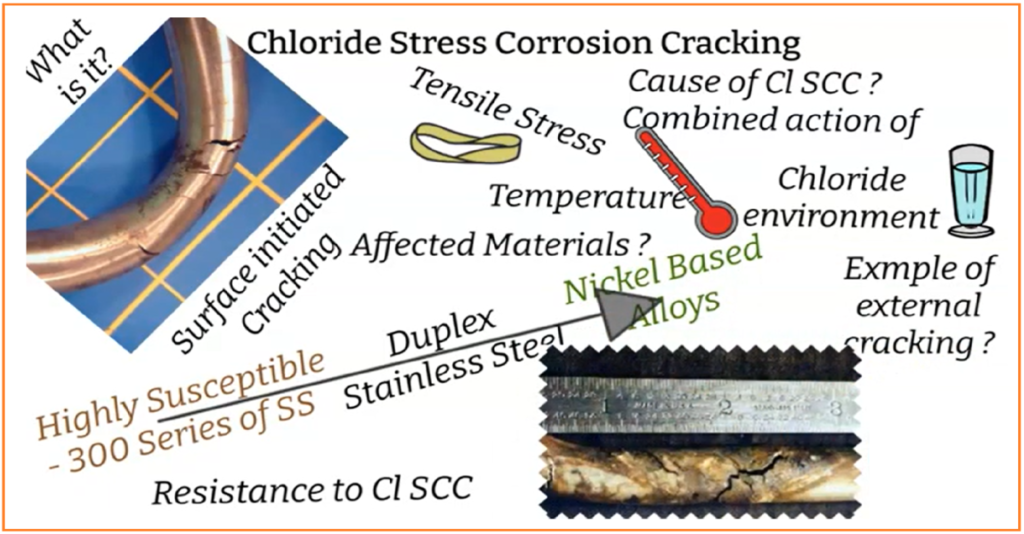In the world of material degradation and corrosion, Chloride Stress Corrosion Cracking (CI-SCC) stands as a formidable adversary, posing risks to critical infrastructure in various industries. From marine environments to chemical processing plants, the presence of chlorides coupled with tensile stress can lead to the insidious development of cracks in susceptible materials. Understanding the mechanisms behind CI-SCC and implementing effective mitigation strategies are essential for safeguarding infrastructure integrity and preventing potentially catastrophic failures.

Chloride Stress Corrosion Cracking Explanation.
Chloride stress corrosion cracking (CI–SCC) is caused in the stainless steel equipment
when it comes in contact with the aqueous chloride ions from the process streams.
Most susceptible locations are the locations of accumulated stresses weather from
welding, tensile stress from the cold forming or the cyclic stress from vibration or
frequent thermal shocks.
Almost all kind of stainless steels are susceptible to Cl‐SCC, but
most affected are the 300 series of SS. However carbon steel and low alloy steels are
not susceptible to this kind of damage. The critical factors which promote this kind of
damage are, high concentration of Chloride ions, higher temperature, lower pH, and
accumulated stresses.
Chloride stress corrosion cracking is caused by internal as well as external process
environments. Stainless steel equipment handling the process streams containing the
chlorides often shows unwarned cracking due to Cl‐SCC. The SS expansion bellows are
also highly susceptible to this kind of CSS due to accumulated stresses. If the SS
equipment is insulated, proper inspection of these equipment is must to avoid
accumulation of moisture in the insulation wool. The marine and industrial
environments usually have high chloride concentration which can accelerate the
external CI–SCC.
Further details on this damage mechanism can be seen from API‐RP‐571 Para 4.5.1.
The Mechanism:
CI-SCC is a complex phenomenon driven by the interplay of several factors. Chloride ions, ubiquitous in environments like seawater or industrial settings, initiate localized corrosion on material surfaces. Concurrently, tensile stresses, whether from external loads or residual stresses, create areas of elevated stress concentration. When these factors converge, cracks can initiate and propagate along grain boundaries, even at stress levels below the material’s yield strength.
Effects and Risks:
The consequences of CI-SCC can be severe, ranging from structural integrity compromise to complete system failure. In industries such as oil and gas, where pipelines are exposed to chloride-rich environments, undetected CI-SCC can lead to catastrophic leaks, environmental damage, and economic losses. Similarly, in aerospace applications, CI-SCC in critical components can compromise aircraft safety.
Mitigation Strategies:
Preventing and mitigating CI-SCC requires a multifaceted approach:
- Material Selection: Choosing materials with high resistance to chloride-induced corrosion is paramount. Austenitic stainless steels, nickel-based alloys, and certain non-ferrous metals exhibit greater resistance and are preferred in chloride-rich environments.
- Environmental Control: Minimizing exposure to chloride-containing environments can reduce the risk of CI-SCC. Proper coatings, inhibitors, and maintenance practices can help mitigate corrosion.
- Stress Management: Design considerations aimed at minimizing tensile stress concentrations, as well as stress relief treatments, are crucial for mitigating CI-SCC. Additionally, ensuring proper installation and operational practices can help alleviate stress on materials.
- Inspection and Monitoring: Regular inspection and monitoring programs are essential for detecting early signs of corrosion and cracking. Non-destructive testing techniques, such as ultrasonic testing and eddy current testing, can aid in identifying potential CI-SCC initiation sites.
Chloride Stress Corrosion Cracking (CI-SCC) poses significant challenges to industries reliant on materials exposed to chloride-containing environments. By understanding the mechanisms driving CI-SCC and implementing effective prevention and mitigation strategies, stakeholders can mitigate risks, enhance infrastructure integrity, and ensure the safety and reliability of critical systems. Vigilance, proactive maintenance, and continuous improvement efforts are key to combating the threat posed by CI-SCC and safeguarding against potential disasters.